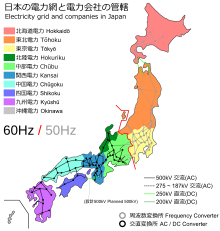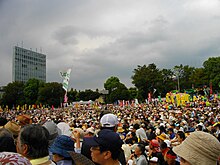Electricity sector in Japan
| Data | |
|---|---|
| Share of renewable energy | 9.7% (2009) |
| Average electricity use (2012) | 988.9 TWh |
The electric power industry in Japan covers the generation, transmission, distribution, and sale of electric energy in Japan. Japan consumed 988.9 TWh of electricity in 2012.[1]
Consumption
In 2008, Japan consumed an average of 8507 kWh/person of electricity. That was 115% of the EU15 average of 7409 kWh/person and 95% of the OECD average of 8991 kWh/person.[2]
| Electricity per person in Japan (kWh/ hab.)[2] | ||||||||||||
|---|---|---|---|---|---|---|---|---|---|---|---|---|
| Use | Production | Import | Imp. % | Fossil | Nuclear | Nuc. % | Other RE | Bio+waste* | Wind | Non RE use* | RE % | |
| 2004 | 8,459 | 8,459 | 0 | 5,257 | 2,212 | 26.1% | 844 | 146 | 7,469 | 11.7% | ||
| 2005 | 8,633 | 8,633 | 0 | 5,378 | 2,387 | 27.6% | 715 | 153 | 7,765 | 10.1% | ||
| 2006 | 9,042 | 9,042 | 0 | 6,105 | 2,066 | 22.8% | 716 | 154 | 8,171 | 9.6% | ||
| 2008 | 8,507 | 8,507 | 0 | 5,669 | 2 010 | 23.6% | 682 | 147 | 7,679 | 9.7% | ||
| 2009 | 8,169 | 8,169 | 0 | 5,178 | 2,198 | 26.9% | 637* | 128 | 27* | 7,377 | 9.7% | |
| * Other RE is waterpower, solar and geothermal electricity and wind power until 2008 * Non RE use = use – production of renewable electricity * RE % = (production of RE / use) * 100% Note: European Union calculates the share of renewable energies in gross electrical consumption. | ||||||||||||
Compared with other nations, electricity in Japan is relatively expensive.[3]
Transmission

Electricity transmission in Japan is unusual because the country is divided for historical reasons into two regions each running at a different mains frequency.
Eastern Japan (including Tokyo, Kawasaki, Sapporo, Yokohama, and Sendai) runs at 50 Hz; Western Japan (including Okinawa, Osaka, Kyoto, Kobe, Nagoya, Hiroshima) runs at 60 Hz. This originates from the first purchases of generators from AEG for Tokyo in 1895 and from General Electric for Osaka in 1896.[4][5]
This frequency difference partitions Japan's national grid, so that power can only be moved between the two parts of the grid using frequency converters, or HVDC transmission lines. The boundary between the two regions contains four back-to-back HVDC substations which convert the frequency; these are Shin Shinano, Sakuma Dam, Minami-Fukumitsu, and the Higashi-Shimizu Frequency Converter.[citation needed] The total transmission capacity between the two grids is 1.2 GW.[6]
The limitations of these links has been a major problem in providing power to the areas of Japan affected by the Fukushima nuclear accidents.[4]
Mode of production
| Gross production of electricity by power source in Japan (TWh)[7] | |||||||
|---|---|---|---|---|---|---|---|
| Production | Coal | Gas | Oil | Nuclear | Hydro | Other | |
| 2004 | 1,071 | 294 (27.45%) | 244 (22.78%) | 133 (12.42%) | 282 (26.33%) | 94 (8.78%) | 24 (2.24%) |
| 2008 | 1,075 | 288 (26.80%) | 283 (26.33%) | 139 (12.93%) | 258 (24.00%) | 83 (7.72%) | 24 (2.23%) |
| 2009 | 1,041 | 279 (26.80%) | 285 (27.38%) | 92 (8.84%) | 280 (26.90%) | 82 (7.88%) | 23 (2.21%) |
According to the International Energy Agency the Japan gross production of electricity was 1,041 TWh in 2009, making it the world's third largest producer of electricity with 5.2% of the world's electricity.[7][8] After Fukushima, Japan imported and additional 10 million short tons of coal and liquefied natural gas imports rose 24% between 2010 and 2012 mostly consumed in the power sector (64%).[9]
Nuclear power
This section's factual accuracy may be compromised due to out-of-date information. (July 2012) |


Nuclear energy was a national strategic priority in Japan, but there has been concern about the ability of Japan's nuclear plants to withstand seismic activity.
Following an earthquake, tsunami and the failure of cooling systems at the Fukushima I nuclear power plant on March 11, 2011, a nuclear emergency was declared. This was the first time a nuclear emergency had been declared in Japan, and 140,000 residents within 20 km of the plant were evacuated. The total amount of radioactive material released during the incident is unclear, as the crisis is ongoing.[12]
On 6 May 2011, Prime Minister Naoto Kan ordered the Hamaoka nuclear power plant be shut down as an earthquake of magnitude 8.0 or higher was likely to hit the area within the next 30 years.[13][14][15] Kan wanted to avoid a possible repeat of the Fukushima disaster,[16] and, on 9 May 2011, Chubu Electric decided to comply with the government's request. Kan later called for a new energy policy with less reliance on nuclear power.[17]
By October 2011, only 11 nuclear power plants were operating in Japan. There were electricity shortages following the power off of most nuclear plants, but Japan passed the summer of 2011 without the extensive blackouts that had been predicted previously.[18][19][20] All 50 nuclear plants were put on hold by early 2012, and the Japanese government warned that voluntary power-saving may not be enough to prevent a massive electricity shortage the next summer. An energy white paper, approved by the Japanese Cabinet in October 2011, says "public confidence in safety of nuclear power was greatly damaged" by the Fukushima disaster, and it calls for a reduction in the nation’s reliance on nuclear power.[21]
Of Japan's 50 nuclear reactors all will go offline on 15 September 2013, leaving Japan without atomic energy for only the second time in almost 50 years.[22] In mid 2011 energy conservation policies were applied leading to a 12% reduction in electrical use.[23]
Carbon dioxide emissions from the electricity industry rose in 2012, reaching levels 39% more than when the reactors were in operation.[24]
Hydro power
Hydroelectricity is Japan's main renewable energy source, with an installed capacity of about 27 GW, or 16% of the total generation capacity, of which about half is pumped-storage. The production was 73 TWh in 2010.[25] As of September 2011, Japan had 1,198 small hydropower plants with a total capacity of 3,225 MW. The smaller plants accounted for 6.6 percent of Japan's total hydropower capacity. The remaining capacity was filled by large and medium hydropower stations, typically sited at large dams.
Other renewables
The Japanese government announced in May 2011 a goal of producing 20% of the nation's electricity from renewable sources, including solar, wind, and biomass, by the early 2020s.[26]
Citing the Fukushima nuclear disaster, environmental activists at a United Nations conference urged bolder steps to tap renewable energy so the world doesn't have to choose between the dangers of nuclear power and the ravages of climate change.[27]
Benjamin K. Sovacool has said that, with the benefit of hindsight, the Fukushima disaster was entirely avoidable in that Japan could have chosen to exploit the country's extensive renewable energy base. Japan has a total of "324 GW of achievable potential in the form of onshore and offshore wind turbines (222 GW), geothermal power plants (70 GW), additional hydroelectric capacity (26.5 GW), solar energy (4.8 GW) and agricultural residue (1.1 GW)."[28]
One result of the Fukushima Daiichi nuclear disaster could be renewed public support for the commercialization of renewable energy technologies.[29] In August 2011, the Japanese Government passed a bill to subsidize electricity from renewable energy sources. The legislation will become effective on 1 July 2012, and require utilities to buy electricity generated by renewable sources including solar power, wind power and geothermal energy at above-market rates.[30]
As of September 2011[update], Japan plans to build a pilot floating wind farm, with six 2-megawatt turbines, off the Fukushima coast.[31] After the evaluation phase is complete in 2016, "Japan plans to build as many as 80 floating wind turbines off Fukushima by 2020."[31]
Power stations
See also
References
- ^ "2014 Key World Energy Statistics". www.iea.org. IEA. Retrieved 7 April 2015.
- ^ a b Energy in Sweden, Facts and figures, The Swedish Energy Agency, (in Swedish: Energiläget i siffror), Table: Specific electricity production per inhabitant with breakdown by power source (kWh/person), Source: IEA/OECD 2006 T23, 2007 T25, 2008 T26, 2009 T25 and 2010 T49.
- ^ Nagata, Kazuaki, "Utilities have monopoly on power", Japan Times, 6 September 2011, p. 3.
- ^ a b A legacy from the 1800s leaves Tokyo facing blackouts, ITworld, March 18, 2011
- ^ Gordenker, Alice, "Japan's incompatible power grids", Japan Times, 19 July 2011, p. 9.
- ^ "Japan - Analysis overview". http://www.eia.gov/. EIA. Retrieved 15 April 2015.
{{cite web}}: External link in|website= - ^ a b IEA Key World Energy Statistics 2011, 2010, 2009, 2006 IEA October, pages electricity 27 gas 13,25 fossil 25 nuclear 17
- ^ Bird, Winifred, "Powering Japan's future", Japan Times, 24 July 2011, p. 7.
- ^ http://www.eia.gov/todayinenergy/detail.cfm?id=13711
- ^ Tomoko Yamazaki and Shunichi Ozasa (June 27, 2011). "Fukushima Retiree Leads Anti-Nuclear Shareholders at Tepco Annual Meeting". Bloomberg.
- ^ Mari Saito (May 7, 2011). "Japan anti-nuclear protesters rally after PM call to close plant". Reuters.
- ^ Weisenthal, Joe (11 March 2011). "Japan Declares Nuclear Emergency, As Cooling System Fails At Power Plant". Business Insider. Retrieved 11 March 2011.
- ^ Story at BBC News, 2011-05-06. retrieved 2011-05-08
- ^ Story at Digital Journal. retrieved 2011-05-07
- ^ Story at Bloomberg, 2011-05-07. retrieved 2011-05-08]
- ^ "Japan nuke plant suspends work". Herald Sun. May 15, 2011.
- ^ M. V. Ramana (July 2011). "Nuclear power and the public". Bulletin of the Atomic Scientists. p. 44.
- ^ Stephanie Cooke (October 10, 2011). "After Fukushima, Does Nuclear Power Have a Future?". New York Times.
- ^ Antoni Slodkowski (June 15, 2011). "Japan anti-nuclear protesters rally after quake". Reuters.
- ^ Hiroko Tabuchi (July 13, 2011). "Japan Premier Wants Shift Away From Nuclear Power". New York Times.
- ^ Tsuyoshi Inajima and Yuji Okada (Oct 28, 2011). "Nuclear Promotion Dropped in Japan Energy Policy After Fukushima". Bloomberg.
- ^ Fukushima: Japan promises swift action on nuclear cleanup Prime minister Shinzo Abe makes pledge amid growing concern at scale and complexity of operation The Guardian 2 September 2013
- ^ http://www.world-nuclear.org/info/Country-Profiles/Countries-G-N/Japan/
- ^ http://www.world-nuclear.org/info/Country-Profiles/Countries-G-N/Japan/
- ^ EIA Country Analysis Briefs - Japan (2012)
- ^ Bird, Winifred, "Distribution gridlock restricts renewables", Japan Times, 24 July 2011, p. 8.
- ^ Denis Gray (April 6, 2011). "Activists call for renewable energy at UN meeting". The Guardian.
- ^ Benjamin K. Sovacool (2011). Contesting the Future of Nuclear Power: A Critical Global Assessment of Atomic Energy, World Scientific, p. 287.
- ^ Justin McCurry (3 May 2011). "Japan's nuclear energy debate: some see spur for a renewable revolution". CSMonitor.
- ^ Chisaki Watanabe (26 August 2011). "Japan Spurs Solar, Wind Energy With Subsidies, in Shift From Nuclear Power". Bloomberg.
- ^ a b "Japan Plans Floating Wind Power Plant". Breakbulk. 16 September 2011. Retrieved 12 October 2011.
